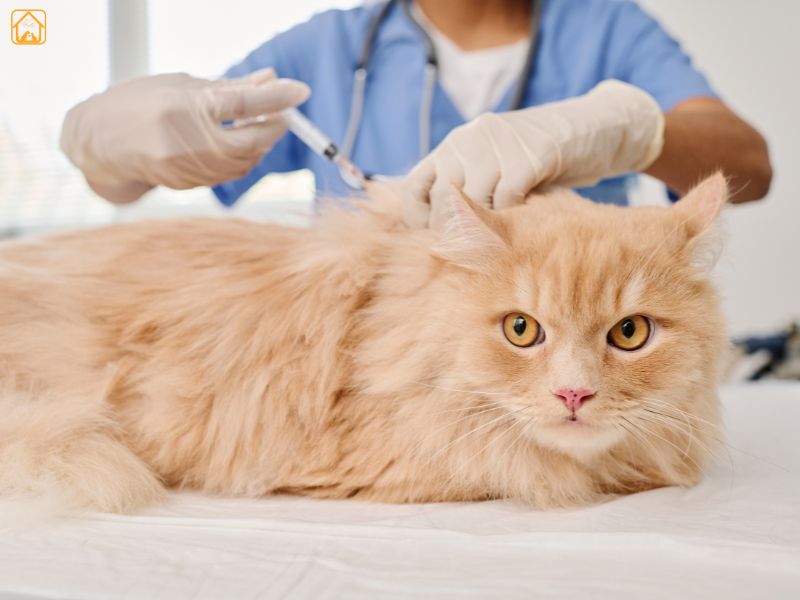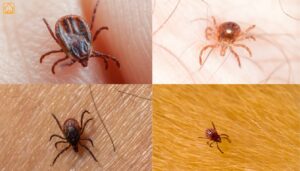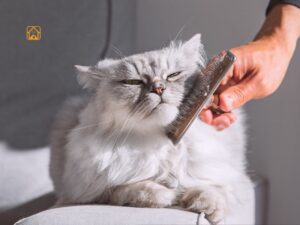Understanding Persian Cat Health: Unique Traits & Genetic Risks
Persian cats with their stunning looks, those huge eyes and plush coats came from centuries of careful breeding. But here’s the thing, that same breeding has also packed them with a few extra health risks. If you’ve ever wondered why so many Persian cat health issues pop up, it starts with their genes and physical traits.
Persians are classified as a brachycephalic breed. That means they have a flat face and shortened nose, which looks adorable but can cause breathing challenges. Their long, dense fur is beautiful, yet it makes them more prone to skin issues and grooming problems.
Persians have a narrower gene pool due to selective breeding, which increases the risk of hereditary diseases. This means that even the healthiest-looking Persian can carry genes for conditions like polycystic kidney disease (PKD) or progressive retinal atrophy (PRA). And because of their flat faces, these cats are more likely to face breathing and eye challenges from a young age.
Here’s a quick rundown of why their breed matters for health:
- Flat faces can mean airway issues, dental crowding, and eye discharge.
- Thick coats may lead to matting, skin rashes, or fungal infections if not groomed regularly.
- Inherited conditions (like polycystic kidney disease) are more common due to selective breeding.
- Indoor lifestyle helps protect them, but also increases risks like obesity and less exercise.
Ever noticed your Persian cat making snuffly noises when they nap? Or spending extra time cleaning their eyes? That’s the breed in action, part cuteness, part health challenge.
Most Common Persian Cat Health Issues
If you’re browsing Persian cat health issues in Reddit threads or chatting with other Persian owners, you’ll notice a few topics come up again and again. Persian cats are more likely than many breeds to develop certain chronic conditions. Here are the issues you’ll want to watch for:
- Polycystic kidney disease (PKD): A genetic disorder that causes cysts in the kidneys, often leading to kidney failure if not managed.
- Brachycephalic airway syndrome: Difficulty breathing due to their short nasal passages and flat faces.
- Dental disease: Overcrowded or misaligned teeth can lead to tartar, gum infections, and tooth loss.
- Eye problems: Excessive tearing, cherry eye, and progressive retinal atrophy are common Persian cat health conditions.
- Skin and coat issues: Their dense fur is prone to matting, while their skin can develop infections or seborrhea.
- Obesity and diabetes: Persians are naturally less active, which increases risks for weight-related health problems.
- Heart disease (Hypertrophic cardiomyopathy): Especially in older cats.
These are classic Persian cat health problems and, with the right care, many can be managed so your kitty enjoys a long, comfortable life.
Genetic Disorders in Persian Cats
Polycystic Kidney Disease (PKD)
PKD is one of the most talked-about Persian cat health issues. It’s a hereditary condition where cysts form in the kidneys. Over time, these cysts grow and can eventually cause kidney failure. About one in three Persians carries the gene for PKD, which means early detection is key. Genetic testing is available, and responsible breeders will screen for this before breeding.
Progressive Retinal Atrophy (PRA)
PRA affects the eyes and leads to gradual vision loss, sometimes resulting in total blindness. It can show up in kittens or later in adulthood. While there’s no cure, antioxidant supplements and regular eye exams can help slow progression and preserve vision for as long as possible.
Hypertrophic Cardiomyopathy (HCM)
This is a heart muscle disease seen in many Persians. The heart walls thicken, making it work harder. Early on, you might not notice anything, but as it progresses, you’ll see signs like panting, lethargy, or sudden weakness. HCM can be managed with diet and medication if caught early.
Brachycephalic Airway Syndrome
Flat-faced Persians (like Himalayans and Chinchillas) are at risk. Their short noses and soft palates can block airways, making breathing noisy or labored. Hot weather and stress make it worse. Some cats need surgery, while others get by with careful home management, like keeping them cool and calm.
Other Inherited Risks
Persians may also be at higher risk for hip dysplasia, and some immune system disorders. If you notice any odd changes, like drinking more water, bumping into furniture, or sudden lethargy, don’t wait. Get your vet involved. Quick action makes a difference.
Brachycephalic Syndrome: Respiratory & Dental Concerns
Breathing Issues
Those iconic flat faces? They come with a price. Brachycephalic airway syndrome is a collection of breathing problems caused by short nasal passages and small nostrils. Your Persian might snore, wheeze, or struggle on hot days. Some cats even faint after strenuous play. It’s a tough thing to watch, but knowing the signs helps you step in early.
Dental Health
That same facial structure can crowd the mouth, causing teeth to overlap or grow at odd angles. Plaque and tartar build up quickly, which means gum disease is a big risk. Regular brushing and dental checkups can save your cat from painful infections or extractions down the road. Honestly, I never thought I’d be brushing a cat’s teeth, but with Persians, it’s a must.
Skin, Coat, and Eye Health Challenges
Coat and Skin Problems
Persian cats have a double coat that mats easily. Without daily grooming, it can become tangled, greasy, or even cause painful skin rashes. Some Persians are prone to seborrhea, which leads to itchy, flaky, or oily skin. Fleas, fungal infections, and allergies can also pop up more often due to their dense fur.
Eye Issues
Those big, beautiful eyes are especially sensitive. Tear staining (brownish streaks under the eyes), cherry eye, and infections are frequent Persian cat health concerns. Watery discharge is common, but excessive or colored discharge means it’s time to see your vet. Regularly wiping the eyes with a gentle, pet-safe solution helps keep things clear.
Ever had to untangle a stubborn mat from your Persian’s belly while they squirm in protest? Trust me, daily brushing is a lifesaver.
Diet, Nutrition & Preventing Obesity in Persian Cats
Persians are naturally less active and more prone to weight gain, making diet a top priority. A well-balanced, high-protein, low-carb diet supports healthy digestion, muscle maintenance, and immune function. Avoid fillers and opt for food rich in animal protein, healthy fats, and moisture.
Obesity Risks & Prevention
Obesity can lead to diabetes, joint issues, liver disease, and worsen respiratory problems. To keep your Persian cat healthy, measure portions carefully, limit treats, and offer regular play sessions. Wet food is often a better choice than dry, as it adds needed hydration and helps prevent urinary problems.
You know what’s funny? My Persian will ignore a room full of toys, but jingle a treat bag and she’ll sprint, so I use those treats for exercise motivation!
Persian Cat Health Care: Grooming, Exercise
Grooming Routine
Daily brushing is non-negotiable. It keeps mats away, reduces shedding, and helps you spot skin issues early. Bathing every few weeks (with cat-safe shampoo) is helpful, too. Always check their ears and eyes during grooming sessions.
Exercise & Enrichment
Persian cats may be laid-back, but they still need play and activity to stay fit. Try wand toys, laser pointers, or even puzzle feeders. Set aside at least 20-30 minutes a day for interactive play. It’s good for both of you, I’ve found these sessions help me unwind, too.
Vet Visits & Preventive Care
Regular vet checkups (at least once a year, or more for seniors) are essential for catching Persian cat health problems early. Vaccinations, dental cleanings, and routine blood work help keep trouble at bay. If your cat’s eating, drinking, or litter habits change, don’t wait for the yearly visit, call your vet.
Persian Kitten Health Issues: Early Detection & Care
Watch for signs of trouble like poor weight gain, constant sneezing, watery eyes, or loose stools. Some hereditary problems, like PKD and PRA, can be screened for early, ask your breeder or vet about genetic testing.
Common Persian kittens’ health issues include respiratory infections, eye problems, and digestive upsets. Always keep kittens warm, feed a high-quality kitten food, and stick to a set vaccination schedule. Early vet visits set the foundation for a healthy adult life. I’ve seen kittens bounce back from rough starts with just a little extra care, don’t hesitate to ask for help if your new fluffball seems off.
FAQs: Persian Cat Health Issues
What are the most common Persian cat health issues?
Persians are prone to polycystic kidney disease, respiratory problems, dental issues, eye concerns, skin conditions, obesity, and heart disease. Each requires careful management and regular vet attention.
Are Persian cats high maintenance?
Yes. Their long coats need daily grooming, and their health concerns require regular monitoring. But for many, the extra effort is worth the love and companionship they offer.
How can I prevent PKD in my Persian cat?
While PKD is genetic, you can reduce risk by choosing a kitten from a breeder who screens for PKD. If your cat has PKD, work with your vet on a special diet and regular monitoring to manage the condition.
Why does my Persian cat have watery eyes?
Their facial structure causes tears to spill out rather than draining properly. Gentle daily cleaning helps, but if discharge is colored or excessive, see a vet to rule out infection or injury.
What’s the best diet for Persian cats?
High-protein, low-carbohydrate foods with real animal ingredients are ideal. Wet food helps with hydration. Avoid fillers and artificial additives. Always provide fresh water.
How often should Persians see the vet?
At least once a year for healthy adults. Kittens and seniors (over 7 years) may need more frequent visits. Any sudden change in behavior, eating, or litter habits should prompt a vet appointment.
Are Persian kittens more at risk for health problems?
They can be, especially for respiratory and eye issues. Early vet checks, vaccinations, and careful monitoring are essential for catching and managing problems quickly.
Conclusion
Remember, while Persian cats have more health risks than some breeds, many live long, joyful lives with attentive care. Your love, patience, and a little preparation go a long way. If you ever have doubts, reach out to your vet or connect with other Persian parents online, sometimes, the best advice comes from someone who’s been there, fur on their shirt and all.



